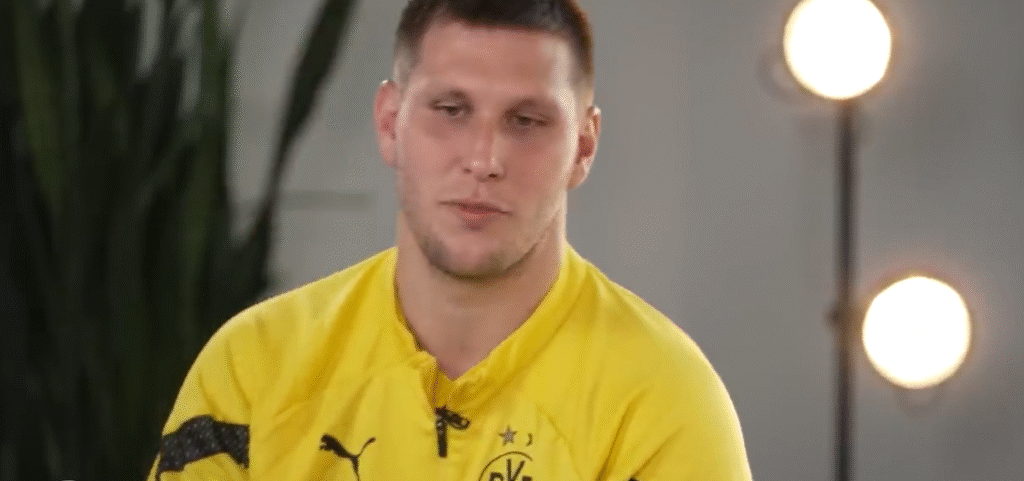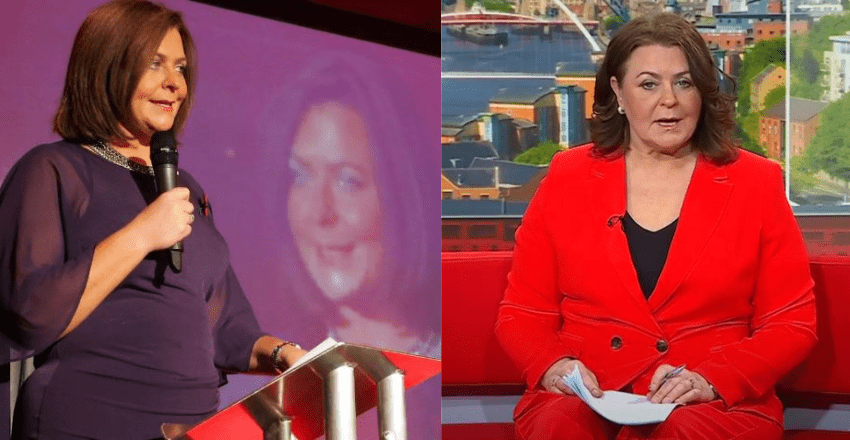Niklas Süle, who stands 1.95 meters tall and weighs 99 kilograms, is much more than just a defensive mainstay for Borussia Dortmund; he has evolved into a symbol of tenacity that is frequently influenced more by appearance than by ability. His physical metamorphosis, which is regularly analyzed by both fans and the media, reveals a story that is both intensely private and awkwardly public. Pundits didn’t hesitate when pictures of Süle looking out of form—heavier, slower, and obviously exhausted—surfaced. There were rumors that he weighed more than 110 kg at one point. Süle, however, leaned into the pressure with remarkably composed resolve rather than flinching away from the storm.
That resolve has produced a noticeably thinner body and a more focused playing presence over the last 12 months. The off-season became a proving ground. According to reports, Süle lost about 8 kg after completing a rigorous fitness regimen designed to improve both her performance and her weight. Despite being physical, the shift exuded psychological clarity. Hans-Joachim Watzke, the CEO of Dortmund, called the return “exceptionally motivating,” not only for the team’s younger players but also for German football players who have faced comparable scrutiny. Once the subject of jests and memes, Süle has returned as a focused athlete who is lighter, faster, and incredibly skilled in defense.
Niklas Süle: Player Profile and Career Stats
| Attribute | Detail |
|---|---|
| Full Name | Niklas Süle |
| Date of Birth | September 3, 1995 |
| Place of Birth | Frankfurt am Main, Germany |
| Nationality | German |
| Height | 1.95 m |
| Weight (Current) | 99 kg |
| Weight (Highest) | 110+ kg (Reported, 2024) |
| Current Club | Borussia Dortmund |
| Position | Centre-Back / Right-Back |
| Shirt Number | 25 |
| Bundesliga Matches | 285 |
| Goals Scored | 16 (Career Bundesliga) |
| International Caps | 49 (Germany) |
| Titles & Honours | 5x Bundesliga Champion, Champions League Winner (2019/20) |
| Former Clubs | Bayern Munich, Hoffenheim, Darmstadt, Eintracht Frankfurt |
| Reference | Bundesliga Official Profile |
Ironically, Süle’s form became a topic of discussion during the pandemic-era seasons, frequently overshadowing his gameplay. His gait, body fat percentage, and even the puffiness in his face were all examined by observers. The voyeurism, which is typically reserved for celebrities in the tabloid circuit, was almost clinical in nature. However, it wasn’t the first time an athlete had to deal with this kind of attention. Zion Williamson’s erratic fitness levels became late-night TV jokes, and Serena Williams has long battled unjust expectations regarding body shape. One aspect of Süle’s journey, however, is remarkably similar: it compelled a discussion about appearance versus performance.
Süle’s numbers have significantly improved in the last few weeks. He finished 50 successful passes, won every tackle he made, and covered a total of 7.7 kilometers in 73 minutes of play in Borussia Dortmund’s thrilling 3-2 victory over Borussia Mönchengladbach. These figures feel like more than atonement; they represent deliberate, calculated recalibration, especially when viewed in light of his prior criticism. Süle redesigned his role as a backline transition initiator in addition to a stopper by emphasizing explosive strength and sustained mobility.
The coaching staff at Dortmund used Süle’s fitness regimen as a model. Every week, his body fat measurements were monitored. Cold therapy and yoga were incorporated into recovery periods. His meal plans were redesigned by nutritionists with a focus on lean proteins and anti-inflammatory foods. Interestingly, his mental acuity, which is frequently underestimated, also increased. Higher interception success rates and greater anticipation were mentioned by game analysts. These were holistic enhancements rather than merely athletic ones.
Through personal conviction and strategic coaching support, Süle regained authority in addition to form. Not because he conforms to a certain aesthetic, but rather because he is playing at a high level, his presence on the field commands respect once more. For younger athletes who feel constrained by criticism that is centered on their appearance, this type of comeback is especially motivating, especially in such a media-rich environment. It serves as an example of how emotional maturity and physical toughness can coexist.
By collaborating with Dortmund’s high-performance team, Süle created a remarkably efficient feedback loop—training outcomes directly informed tactical deployment. Because of this synergy, the coaching staff was able to depend on him in crucial games, especially when physical battles and aerial duels required both agility and bulk. Süle has established himself as one of the Bundesliga’s most reliable defenders this season after becoming noticeably faster and fitter.
Weight is more than just a statistic in the context of professional sports; it’s a reflection of readiness, stamina, and reliability. Sports psychologists use Süle’s example to show how one’s identity need not be defined by how others perceive them. Süle increased his self-discipline and didn’t just lose weight by incorporating customized routines. He is not only relevant but also crucial to Dortmund’s hopes of winning the championship because he is incredibly resilient under duress.
The change is evident to fans. Previously disparaging his body, social media posts now honor his tenacity. The tone of former critics has mellowed. His defensive readings have been praised by journalists who once dismissed him. It could be argued that Süle’s redemption story marked a sea change in football culture, emphasizing hard work over beauty.
Dortmund has also started a health-focused fan initiative since his weight loss became public, promoting young people’s involvement in neighborhood fitness programs. Süle has surprisingly emerged as a model for healthy athleticism by turning his personal struggle into a source of inspiration for others. In addition to fans, his story speaks to families, schools, and young athletes attempting to reconcile body image and performance.







